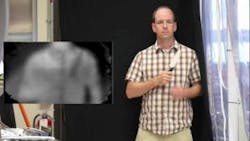NIST video imaging prototype detects hidden weapons and threats
Researchers from the National Institute of Standards and Technology (NIST), have developed a prototype video imaging system that utilizes superconducting technology used in advanced telescope cameras for detecting hidden weapons and threats.
The imager has three features which may offer advantages over screening systems such as those used for airport security, according to NIST:
- The NIST imager is passive, meaning it detects naturally emitted or reflected light, instead of using X-ray or other radiation
- Software developed by NIST weaves together still images to produce video in near real time.
- The system can detect objects 16 to 28 meters away from a target.
NIST’s instrument scans a target to detect emissions of terahertz light and generates images based on variations in temperate and reflected light among different target materials. It utilizes transition-edge sensors that are made of a superconducting metal, which change resistance in response to very faint light. Its 251 sensors can produce images with details as small at 1 cm in size across a target area about 80 by 60 cm.
The system also includes two mirrors and a lens that focuses light on the sensors, a low-temperature refrigerator containing a wafer of sensors and amplifiers, electronics to combine all signals, and the aforementioned software that stitches images together into video. All components were designed and built by NIST aside from part of the refrigerator, which was built at the University of Pennsylvania, and the electronics, which were provided by the University of British Columbia.
The imager detects emissions at a wavelength of 850 µm and has a frame rate of 6 fps, but NIST researchers say that the system can be further developed to have four times as many sensors (1,004) which would produce a much larger video frame rate.
View the NIST press release.
Also check out:
Network video cameras provide perimeter security for Chinese chemical company
FLIR thermal imaging cameras chosen for UK Search and Rescue program
Researchers create remote traffic pollution detection camera prototype
Share your vision-related news by contacting James Carroll, Senior Web Editor, Vision Systems Design
To receive news like this in your inbox, click here.
Join our LinkedIn group | Like us on Facebook | Follow us on Twitter | Check us out on Google +
About the Author

James Carroll
Former VSD Editor James Carroll joined the team 2013. Carroll covered machine vision and imaging from numerous angles, including application stories, industry news, market updates, and new products. In addition to writing and editing articles, Carroll managed the Innovators Awards program and webcasts.
